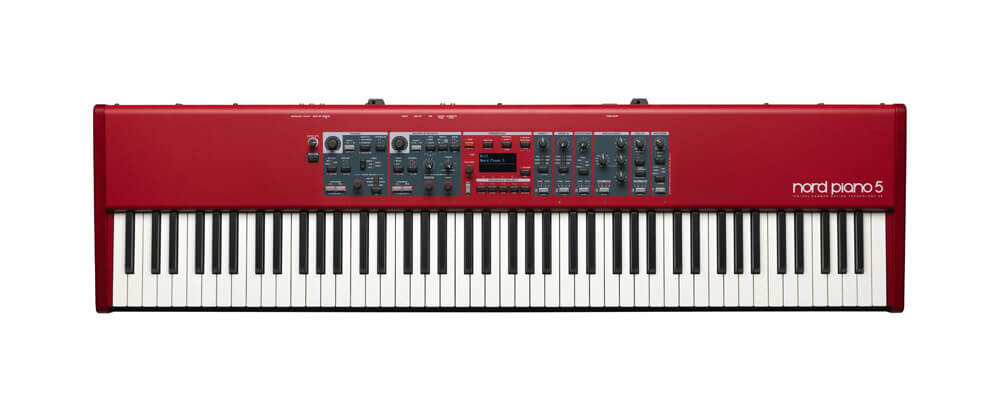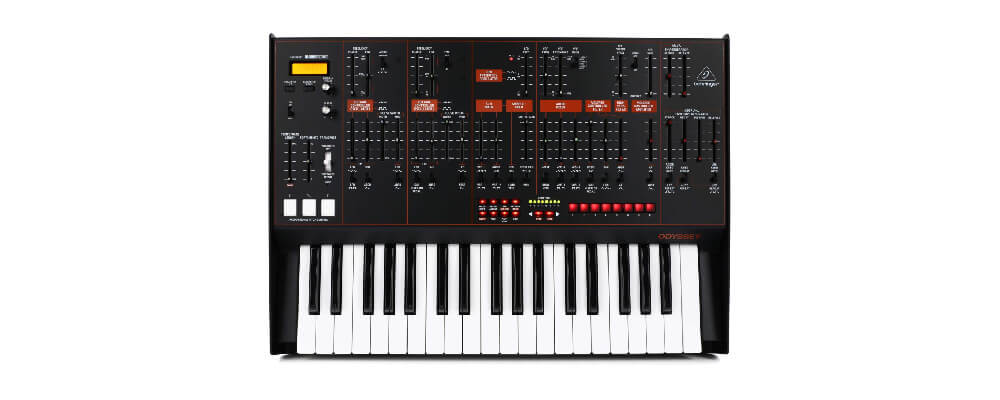Few instruments can claim to be as versatile as the keyboard. So if you’re a musician who needs the flexibility to wield multiple instruments while only having the budget for one, this is probably your best option. Alternately, you might be a seasoned pianist who’s looking for a different sound experience without straying too far from familiar comforts. Again, the keyboard seems like a perfect choice.
Whatever your reason for getting a keyboard, one thing’s certain. The instruments have come a long way since their debut. Current models stretch from sleek, minimalistic devices to futuristic button-covered bricks, so you’ve got lots of choices. Just in case you’re feeling overwhelmed by all the possibilities, here’s a nifty guide that’ll break it down and hopefully point you in the right direction.
Does keyboard size matter?

First things first. Make like a good locksmith and think about how many keys you’ll need. If you’re strapped for space or want something simple to tinker on, a petite 32 or 49-key model could do the trick. As a plus, the smaller size makes them infinitely more portable. Definitely something to remember if you’re planning on busking or touring with your keyboard.
If you’d like to elevate your music further, there are always 61-key, 73-key, or even full 88-key versions. They’re not much harder to master, and the increased number of keys makes for a wider musical range. After all, some songs run the entire gamut of octaves. Your fingers will feel less cramped, and there’ll even be room for someone else to join in on a duet.
Key action and sensitivity

Veteran pianists might put more weight (pun unintended) on this factor. Many keyboards have unweighted keys that immediately spring back when played. This makes them perfect for young children or those with weaker fingers who’ll find their lightness easier to handle. But if you’re a seasoned player of the standard acoustic piano (grand or upright), you might find its digital brethren a touch shallow (pun unintended). Keyboard keys usually need less force to depress than those of an acoustic piano, so when you’re switching back and forth between both instruments, it can be a difficult adjustment.
To build up or maintain dexterity and dynamic control, why not try weighted keys? There are three main types of weighted keyboards; semi-weighted, hammer-action, and graded hammer-action. Honestly, you’ll probably have to give each one a whirl to see which one you like best. Just remember these basics. Semi-weighted keys get their resistance from springs and require the least finger strength. Hammer-action ones, on the other hand, replicate the feel of the piano’s hammer-action mechanism. Graded hammer-action keyboards are pretty much the same as hammer-action keyboards – but with graded weighting. Keys on the lower end of the register will be heavier, while keys on the higher end will be lighter. Just like a real piano!
Velocity sensitivity can play a major role in adding texture and emotion to your music. The keys of a non-dynamic keyboard are merely on/off switches, which is fine if you’re in the market for something simple. However, a dynamic keyboard will respond to how much pressure you apply to the keys, much like a regular piano does. That energy is transferred to the audio-producing mechanism. If the key is stroked softly, a lower volume is produced. Likewise, press down hard on a key and the sound becomes louder.
Making sound decisions

Right, that’s the technical stuff out of the way. Here’s where your personal taste really kicks in. Pay close attention to the scope of instrumentals that your keyboard has to offer. Percussion, strings, woodwinds – the sky’s the limit these days. If you’re particularly inventive, look for polyphonic and multitimbrality capabilities. These handy modules have a bunch of tricks up their sleeves. You can layer different sounds or timbres over one another, split the keyboard at any given point, and even set a bass or drum accompaniment for your solo masterpiece. Simply put, you’ll have a ready-made ensemble right at your fingertips.
Production value

The multifaceted keyboards of today aren’t just standalone instruments. Many options overlap with synth and MIDI capabilities, along with other music-creation tools. If these sound like what you need, search for an all-in-one keyboard workstation. While the type of features will obviously come down to individual preference, there are a few things you could consider:
Connectivity
We live in a digital age, so it’s probably no surprise that many keyboards are MIDI compatible, letting the player pair them with digital interfaces (DAWs). It’s definitely not a necessity for casual musicians, but budding composers would do well to consider getting a keyboard with computer connectivity. As a bonus, you probably won’t need to fork out for a newer model any time soon, since software updates will help keep your instrument up-to-date. Performers, take heed! Output is just as important here, so make sure you pick one that hooks up to amps and other recording equipment.
Sequencing, processing, and recording
Whether you’re studio or stage-bound, a resourceful musician will appreciate an instrument with MIDI sequencing. It lets you map accompaniments to unused sections of the keyboard, which can then run concurrently with sequenced backing tracks. Here’s a quick hack for those of you who enjoy performing covers – seek out a keyboard library with tons of pre-programmed MIDI files for effortless options.
Effects processing is another feature that’s becoming increasingly popular with editing-savvy musicians. Think that’s you? Go for a keyboard with sound-shaping tools to refine details like dynamics and EQ.
While you’re at it, why not lay down your own sounds? We touched upon connectivity earlier, so look for a keyboard with a mic/line input so you can hook up a recording device. You’ll be able to incorporate vocals and other instruments into an already sequenced track.
Synth engines
We’ve already covered the sound angle, but it’s recommended you match the synth engine to the type of music you’re hoping to produce Sample-playback synths will do just fine if you’re after realistic piano, string, percussion, and brass sounds. Is electronic music your forte? Then perhaps a design with analogue modelling would be more suitable. If budget isn’t an issue, you can splurge on a high-end workstation that’s set up with multiple synth engines. As an aside, you’ll want to hone in on a keyboard’s sample rate and bit depth if you’re particular about sound quality.
Hardware
Once again, this is a highly personalised deliberation. Minimalists can settle for a simple pitch and mod wheel combo. On the flip side, someone who loves experimenting and having all the options will be thrilled with knobs and sliders that transmit MIDI continuous controller (CC) messages. Use them to adjust FX, sweep filters, and control sequencer levels.
User interface
Keyboards with built-in interfaces can be extra handy if you don’t want the added cost of extra gear. USB interfaces are common, allowing the transfer and archiving of data. If your USB port is capable of passing bi-directional MIDI, try pairing it with a DAW. This enables it to be utilised as a main controller for both virtual instruments and software.
Storage
For prolific songwriters, memory is another factor, especially if it’s upgradeable. Likewise, some keyboards possess removable media capabilities like micro-USB slots. Not only can you download new features directly onto memory cards, but this also preserves your settings and presets in physical form. In the event your keyboard requires reformatting, you won’t have to worry about starting from scratch.
Don’t forget to accessorise

It’s the little things that make the biggest impact, and keyboard adjuncts are no different. Just ask any gigging musicians and they’ll tell you how important it is to have a protective cover to keep your instrument safe and well. Since not all models come with their own cover, seek one out and keep your precious baby free from scratches, spills, and dust. Another handy add-on? Keyboard stands. Unless you want to lug a table around wherever you go, you’ll need these to hold up your instrument while you’re jamming out. Likewise, ponder the humble music stand. Even if you’re more into digital sheet music, it’s a good hands-free perch for phones or tablets. And finally, we’d recommend a plug-in pedal to anyone who wants to get a little bit closer to that authentic acoustic piano experience.
Details, details
This should go without saying, but we’ll say it anyway. Your keyboard should make you happy. If cheap, functional, and reliable are all the buzzwords you need, then get an instrument that fits the bill instead of splurging on a higher-end model. And don’t rule out minor features. For some people, a built-in sheet music holder could make the difference between good and great. The decision is entirely yours to make, and so long as you enjoy playing your keyboard, that’s all that matters.
As you’ve hopefully discovered, knowing your preferences and style will go a long way in choosing the right keyboard. It’s important to go with one that meets your needs, but also makes you excited to play. So don’t feel like you have to settle for the first one that crosses your path. Try out different models, ask for recommendations, and consult this list regularly. With any luck, your perfect match is right around the corner.



